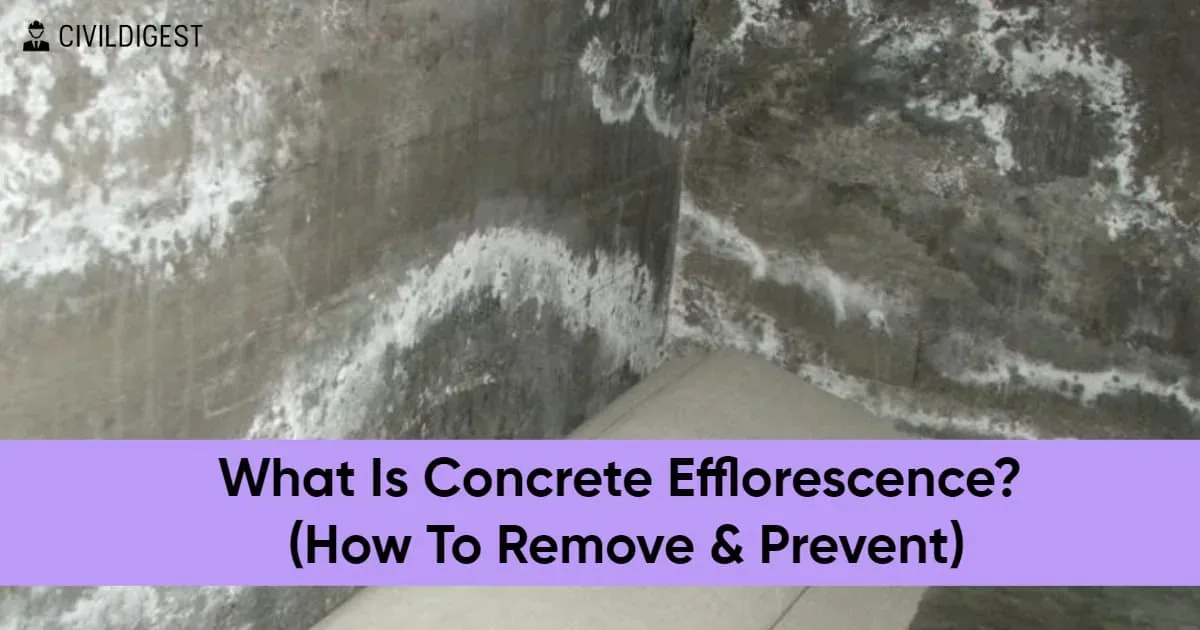Efflorescence is known as white deposits that form on concrete surfaces due to moisture loss. This common issue primarily affects new concrete structures, where various chemicals such as sodium, sulfate, hydroxides, minerals, chlorides, and nitrates accumulate on the surface and within the pores of the material.
In this guide on “What is Concrete Efflorescence?“, we will dive into the causes, potential harm, removal techniques, and preventive measures for dealing with efflorescence in concrete structures.
Table of Contents
What causes efflorescence?
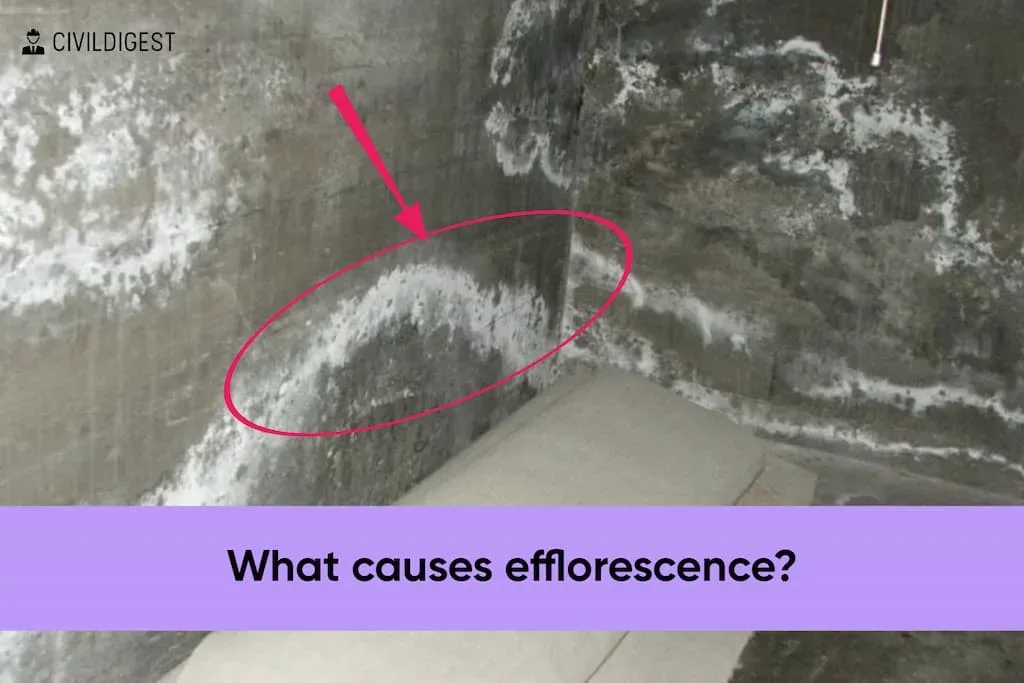
Efflorescence is caused by the presence of soluble salts in masonry materials, such as concrete and brick. These salts become visible on the surface when water containing the dissolved salts moves through the material and evaporates. There are several mechanisms that can contribute to the formation of efflorescence, including:
- Capillary Action: Water is absorbed by the capillary pores in the masonry material, allowing the soluble salts to be transported to the surface.
- Moisture Movement: The movement of moisture within the masonry material can carry the salts to the surface, where they are left behind when the water evaporates.
- Water-Soluble Salts: The salts are present in the building materials themselves, such as in the aggregates used in concrete or the clay in bricks.
- Groundwater: If the masonry is in contact with groundwater, the water can transport the salts to the surface through capillary action.
It is important to note that efflorescence is not caused by the brick itself, but rather by the presence of soluble compounds that are often more visible on the brick due to its darker color and capillary porous nature. The bond between the brick and mortar requires the capillary porous nature of the brick, which can contribute to the transport of water and soluble salts.
To get a better understanding of the specific causes of efflorescence in a particular project, it is important to analyze the materials used, the site conditions, and the moisture sources that may be present. This analysis can help in developing strategies to prevent efflorescence and mitigate its effects.
Is Efflorescence Harmful?
Efflorescence itself is not considered to be a harmful issue. However, if left untreated, it can lead to more serious problems over time. Here are some key considerations regarding the potential harm caused by efflorescence:
- Aesthetic Issues: One of the primary concerns with efflorescence is its visual impact. The white, powdery deposits can detract from the appearance of concrete surfaces or masonry structures, affecting their overall aesthetic appeal.
- Moisture Attack: Efflorescence is a sign of excessive moisture attack on a structure. Ignoring efflorescence can result in unpleasant surprises, such as structural damage or the formation of mold. The presence of moisture can create an ideal environment for mold growth, which can be detrimental to both the structure and occupants’ health.
- Salt Damage: The salts present in the efflorescence can react with other structural materials, leading to gradual damage over time. This chemical reaction can weaken the integrity of the building materials and compromise the strength and durability of the structure.
How to remove efflorescence from concrete?
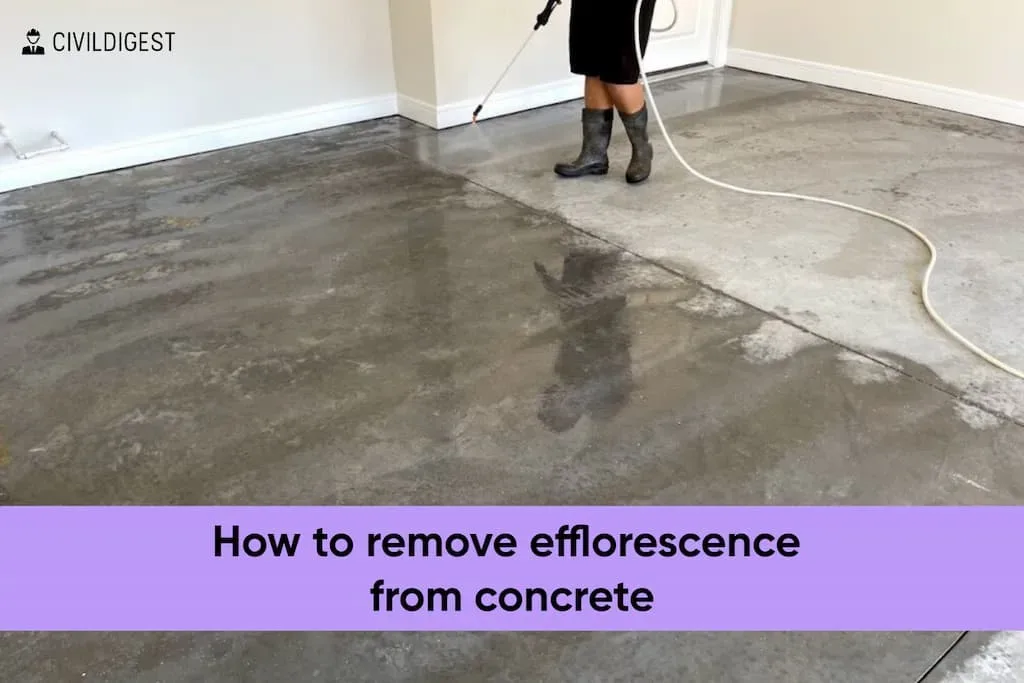
Efflorescence, which is the white powdery deposit that forms on concrete surfaces due to the migration of salts, can be removed with the following techniques:
- Source of Water: The first step in removing efflorescence is to eliminate the source of excessive water that is forcing the migration of salts through the concrete. Fix any water leaks or drainage issues to prevent further efflorescence formation.
- Abrasive Techniques: Most efflorescence, also known as calcium carbonate or limestone, can be removed using abrasive techniques. Dry brushing, light water blasting, or light sandblasting followed by flushing with clean water can help remove the efflorescence. It is best to minimize the use of water during the removal process to avoid triggering the efflorescence reaction again. Note: Prior to removing efflorescence, any previously applied curing and sealing compound must be thoroughly removed.
- Weak Acid Solution Cleaner: If the efflorescence appears to be insoluble in water, a commercially available weak acid solution cleaner or specialty efflorescence remover may be necessary. When using acid solutions, precautions must be taken to prevent surface etching or color change. Test a small, inconspicuous area first and follow the manufacturer’s instructions.
- Precautions: When using acid solutions, follow all safety, handling, and application instructions. Treat an entire surface instead of spot applications to avoid discolored or mottled areas. Dampen the concrete surface with clean water before applying any acid solution to prevent deep absorption. After using acid solutions, thoroughly neutralize the concrete surface with a baking soda and water solution and rinse it multiple times to remove all residue. Dispose of any runoff or materials used according to regulations.
- pH Test: After rinsing, perform a pH test to ensure there is no residual acid present on the surface. A pH of 7 or higher indicates that the surface is ready for sealer application. If the pH is lower than 7, further neutralization is required.
It is important to note that failure to remove all acid residue prior to applying a sealer can lead to appearance defects, reduced adhesion, peeling, and other issues. Allow the surface to dry completely before applying any subsequent coating or adhesive.
By following these steps and precautions, you can effectively remove efflorescence from concrete surfaces and restore their appearance.
Removing efflorescence with vinegar
Vinegar can be an effective and natural solution for removing efflorescence from various surfaces. Here’s how to use vinegar to clean efflorescence:

- Prepare the Vinegar Solution:
- Dampen the affected area with water.
- Mix equal parts of vinegar and water to create a solution.
- Regular white vinegar with 5% acidity is suitable for the task.
- Apply the Vinegar Solution:
- Using a sponge, apply the vinegar solution to the area with efflorescence.
- Clean the area in a circular motion, ensuring even coverage.
- Leave the solution on the surface for about 10 minutes.
- Rinse the Area:
- Thoroughly rinse the area with clean water after the 10-minute waiting period.
- Ensure all traces of the vinegar solution are completely removed.
- Scrub Smooth Surfaces (if necessary):
- If any residue remains after rinsing, use a coarse brush to scrub the surface.
- A stiff-bristled brush works best for this purpose.
- Keep the affected area dry as you scrape away the salt and residue.
- Use a wet sponge or cloth to wipe away any remaining residue.
- Outdoor Efflorescence:
- On a warm, dry day, use pressurized water to remove efflorescence outdoors.
- You can use a pressure washer or a power washer hose attachment.
- Hold the nozzle about 1 foot (0.30 m) from the ground and spray in short side-to-side motions until the efflorescence is gone.
- Dry the area or use a wet vacuum to remove any standing water.
- Chemical Cleaner (as a last resort):
- If efflorescence persists, you can consider using a chemical cleaner like muriatic acid.
- Follow the mixing instructions on the bottle to create an acid solution.
- Before applying the acid solution, presoak the wall or surface with water.
- Let the acid sit for about 5 minutes before using a brush to scrub away the efflorescence.
- Rinse the surface with fresh water to remove the acid solution.
- It is important to wear rubber gloves, safety glasses, and protective clothing during the application of acid solutions.
Note: For pavers, you can also use vinegar, ammonia, or a muriatic acid solution to clean white efflorescence residue. Rinse the pavers with water, pour the cleaning solution over them, let them sit for a few minutes, scrub the surface with a hard brush, and finally rinse everything off with a water hose.
How to remove efflorescence from brick?
To effectively remove efflorescence from brick surfaces, you can consider using a sandblaster or applying a waterproofing sealant. Here’s how you can perform these methods:
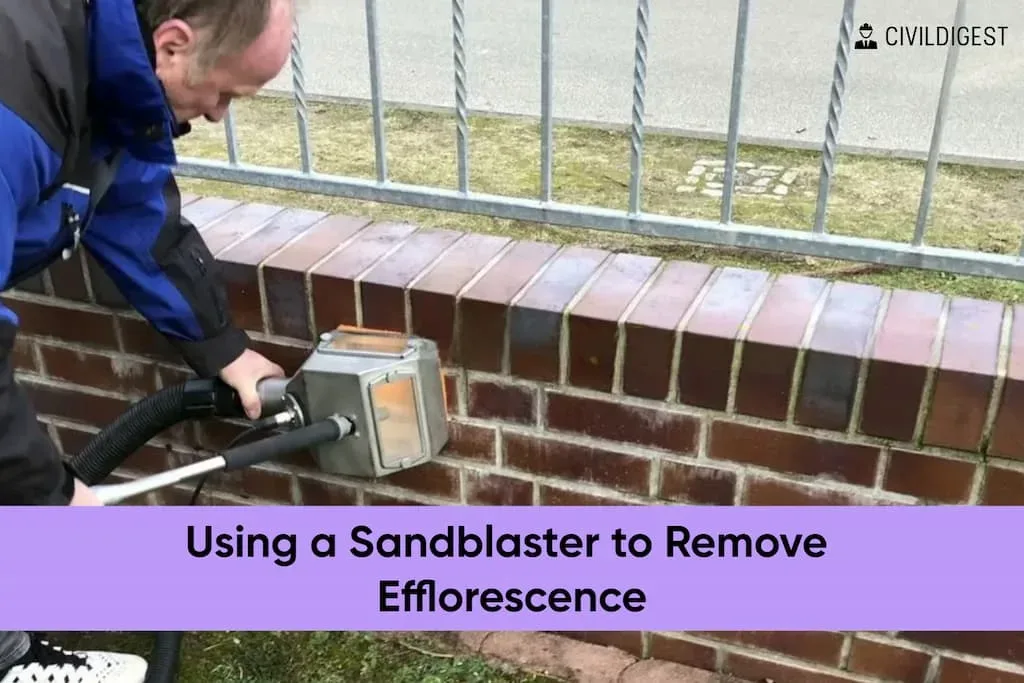
Using a Sandblaster to Remove Stubborn Efflorescence:
- Tools and Materials Needed:
- Sandblaster
- Sandblasting media (fine)
- Drop Cloths
- Duct tape
- Protective clothing
- Waterproofing sealant
- Safety Precautions:
- Before using a sandblaster, protect your eyes and skin by wearing a face shield with a hood, long sleeves, pants, boots, and rubber gloves.
- Make sure your face is completely covered to avoid breathing in debris caused by sandblasting.
- Take steps to protect delicate greenery or other items nearby by using drop cloths secured with duct tape or plastic sheeting.
- Fill the Blasting Bucket:
- Fill the blasting bucket with fine sandblasting media, suitable for removing efflorescence.
- Set the sandblaster to the lowest pressure setting to prevent damaging the bricks.
- Sandblasting Technique:
- Aim the blasting gun at the bricks from a distance of at least 5 inches (13 cm).
- Turn on the sandblaster and use smooth, horizontal movements to wash away the efflorescence.
- Repeat the process for stubborn areas, adjusting the pressure if necessary.
- Seal the Brick:
- After removing efflorescence with a sandblaster, it is crucial to seal the brick to prevent future occurrences.
- Apply a waterproofing sealant specifically designed for bricks.
- Follow the manufacturer’s instructions for application, which may involve spraying or painting the sealant onto the bricks.
- Start from the bottom of the wall and work your way up.
Note: Avoid sandblasting brick that is older than 20 years, as it can cause more harm than good. If you do not feel comfortable using a sandblaster, it is advisable to hire a contractor to perform the task. Additionally, during the application of the waterproofing material, cover plants, windows, and electrical appliances with drop cloths to prevent any accidental damage.
How to remove efflorescence from concrete block walls?
To remove efflorescence from concrete block walls, follow these steps:
Step 1: Collect the necessary tools:
- A bucket filled with warm water
- Liquid dish soap or cleaning vinegar
- Paintbrush or scrubbing brush or automatic scrubbing brush
- Dry cloth
- Protective goggles
- Fan (workshop fan for efficient drying)

Step 2: Make a mixture of soap and warm water:
- Fill a bucket with 5 gallons of warm water
- Add a few drops of liquid dish soap
- Dip a bristle or paintbrush into the mixture
- Scrub the wall thoroughly
Step 3: Use fresh water after using the mixture:
- Change the water in the bucket to avoid reapplying salt particles to the wall
- Rinse the wall with plain water using a clean cloth to remove any remaining soap or efflorescence

Step 4: Use fans to dry the wall:
- Ensure the wall is dried to prevent reabsorption of water and reduce the possibility of efflorescence recurrence
- Use a workshop fan to expedite the drying process for indoor concrete block walls
- For outdoor walls, rely on natural sunlight and wind for drying
Step 5: Clean with strong chemical products (if necessary):
- If scrubbing with dish soap and warm water is insufficient, opt for a chemical cleaner
- Two options include concentrated cleaning vinegar or an indoor/outdoor efflorescence remover
Note: When using any chemical cleaner, follow the instructions on the product label and take necessary safety precautions.
How to prevent efflorescence in concrete?
To prevent efflorescence in concrete, it is crucial to follow good building practices. Here are some key measures to consider:
- Use High-Quality Concrete:
- Opt for low-slump concrete that contains minimal water, making it less prone to efflorescence.
- Choose Clean Aggregates:
- Use sand and gravel for the concrete mix that has been washed to remove impurities.
- Ensure the water used in the mix is pure and salt-free.
- Adding fly ash to the concrete mixture can reduce the water and cement content and bind some salts, thus minimizing efflorescence.
- Low-Alkali Mortar:
- For stone or brickwork, use low-alkali mortar to prevent alkali salts from leaching into the masonry.
- Ensure the mortar is firm, free of cracks, and applied properly.
- Insist on Insoluble Bricks:
- Verify that the manufacturer has added chemicals during brick production to make the salts insoluble and limit efflorescence.
- Proper Curing:
- Ensure concrete or stucco is cured properly. Wet the concrete slab and cover it with plastic during the curing process to increase density and reduce channels for salt migration.
- Consider Sealers or Paints:
- Consult with an expert to determine if applying a sealer or paint can help minimize efflorescence.
- Install Vapor Barriers and Ensure Proper Drainage:
- Use a vapor barrier under the concrete slab to prevent moisture from seeping up.
- Seal footings with a plastic barrier to prevent water ingress from the ground.
- Improve overall drainage to redirect runoff away from the structure, patio, or walls.
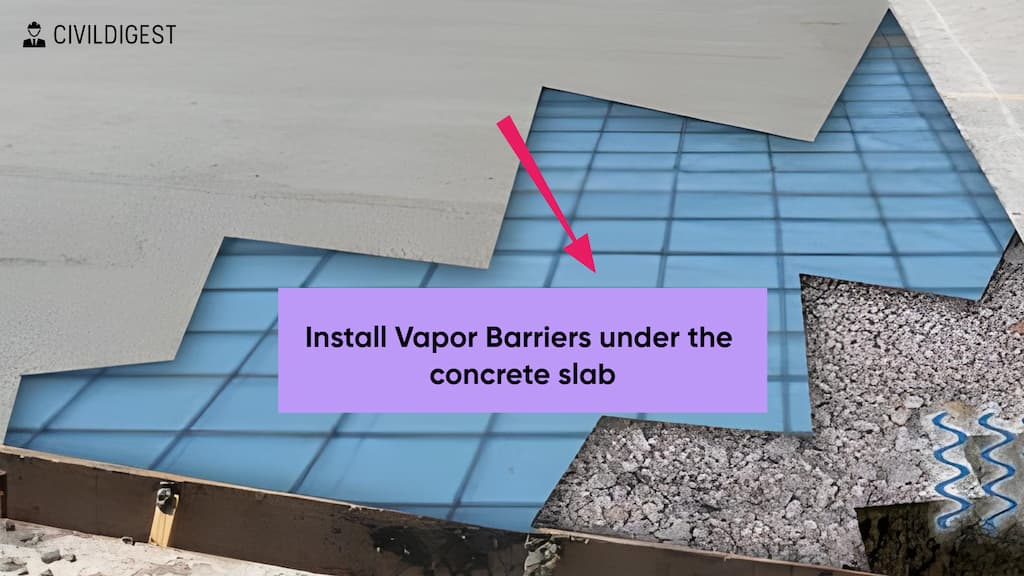
- Regular Maintenance:
- Avoid excessive wetting of the concrete surface from lawn sprinklers or excessive washing.
It is important to note that efflorescence may not be entirely preventable, but these preventive measures can significantly reduce its occurrence. However, even if efflorescence does appear, it is often not a major problem and may eventually diminish on its own over time.
Related: How to Install Conduit in Existing Concrete Slab
[CP_CALCULATED_FIELDS id=”11″]
Conclusion
A clear understanding of concrete efflorescence is indispensable. This white deposit, emerging on concrete due to moisture loss, can compromise both the look and longevity of structures. Diving deep into its causes, gauging its potential harm, and familiarizing oneself with both removal tactics and prevention techniques, equips you to effectively counteract efflorescence.
